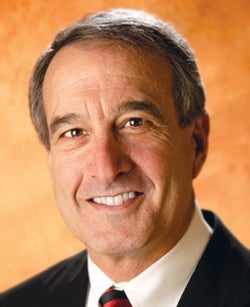The news from Detroit can’t get much worse. And unemployment rates are likely to climb ever higher. But the good news is Massachusetts has a fat check coming from the federal government in the form of stimulus cash.
The man charged with managing a healthy portion of those funds — which have already started trickling into the Bay State — is Jeffrey Simon, the state’s director of infrastructure investment.
Time Served
Simon is no stranger to state government or economic development. He was the lead official overseeing transformation at the former Fort Devens from 1991 to 1995. Today, of course, that site is an economic powerhouse – one that Simon barely recognizes.
“One of the biggest thrills I’ve ever had is going back (to Devens) just over 10 years later and driving in where I went to work every day for nearly four years and getting lost,” he said during a recent interview with the Worcester Business Journal.
Luckily, Simon isn’t disoriented in negotiating between the federal and Massachusetts governments, which is squarely where he finds himself today. His main responsibility is working with a wide swath state agencies — and the state legislature — to make sure all requirements for maximizing federal funding are met.
Gov. Deval Patrick appointed Simon to head up the Office of Infrastructure in February as details began to emerge of President Barack Obama’s stimulus plan. While his resume includes four years at Fort Devens, he most recently was president of Tennessee-based Actus Land Lease, a real estate development company that specializes in public/private projects.
The Massachusetts share of federal stimulus dollars through the American Recovery and Reinvestment Act (ARRA) was originally estimated at approximately $8.7 billion. More recently that number has been adjusted north to $8.9 billion. (Click here to see how the funds break down.)
Simon isn’t responsible for that entire sum. His focus is on the $2 billion earmarked for infrastructure. But that doesn’t just apply to roads, bridges and mass transit. The money is also pegged for alternative and renewable energy projects, including sustainable housing and smart grid improvements, and broadband initiatives.
Why would someone want the responsibility of shepherding billions in tax payer dollars? For Simon, it wasn’t that intimidating given his background in working with state governments on huge projects, like Devens.
“I saw it as a very interesting opportunity for not only getting people back to work, which is the main goal, but for doing that in a strategic way that lays groundwork for long term economic growth of the commonwealth,” he said.
Full Accounting
So, after three months on the job, how much has the state spent on infrastructure? It’s been small doses, but the state is on track to meet a requirement of having $153 million in projects advertised for bid within 120 days of ARRA’s passage.
In total, $1.145 billion in projects under Simon’s infrastructure umbrella have been identified or planned as of May 26. Of that total, $202.7 million is planned for housing and community development, $464.9 million is planned for transportation and $477.1 million is allocated for energy and the environment.
Locally, the City of Worcester is in line to receive $1.7 million in federal ARRA funds for energy efficiency and conservation work.
Several other Central Massachusetts roadway projects are also receiving funding, according to Rich Rydant, a project manager Central Massachusetts Regional Planning Commission. To be eligible for ARRA stimulus money, all roadway projects must be on the state’s transportation improvement program (TIP) list. Regional planning commissions are responsible for compiling those lists.
One of the local roadway projects on tap for federal funds is repaving of a section of Route 32 in Hardwick and New Braintree. The total cost on that project is estimated at $675,000, according to Rydant. Another paving project is $3.3 million of improvements to a section of Route 122 in Barre.
The repaving of Route 20 in Worcester and Shrewsbury is also being funded in part by ARRA funds.
Simon has been hitting the road to talk up these road projects, and he admits he hears a common refrain from business people in the state.
“I get the sense that everyone thinks it’s too late, but it’s absolutely not too late,” Simon said.
There’s also a misconception in the public that the stimulus money is supposed to be funding large-scale Works Progress Administration-type projects. In fact, Simon said that when he first started working with the newly created Office of Infrastructure, the assumption was that the federal government would give states much more leeway in what projects to pursue. In the end, however, the emphasis in the legislation was on so-called “shovel ready” projects. In the case of roadways, that meant projects that had already cleared the hurdles of design and feasibility.
As far as larger infrastructure projects, Simon points to a new $60 million exit ramp in Fall River. But the federal stimulus money will also go to much smaller transportation enhancements. “In terms of something like a new town hall or new department of public works, stadium, park or pool, there aren’t any funds for that,” he said.
The Office of Infrastructure has a web presence (www.mass.gov/recovery) and Simon recommends that business people visit the site to get updates and learn about potential bidding opportunities.

